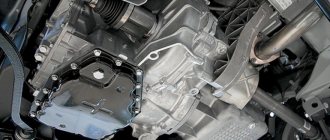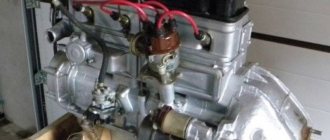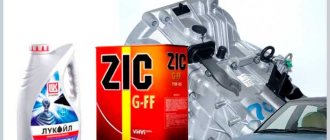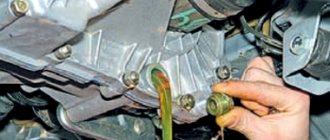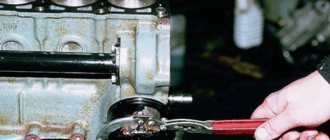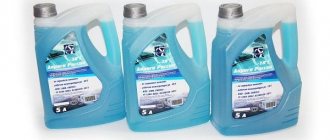Before changing the gearbox oil, the car owner must make sure that all the necessary tools are available for this procedure, including the correct oil. The service life of the transmission depends on the quality of this product, so you need to select the fluid only according to compatible parameters. It is also important to know the frequency of replacement and how much oil to pour into the gearbox. Let's consider all this information using the example of choosing oil for the most popular car in Russia in the early 2000s - VAZ-2112.
Checking the oil level and condition
You can check the transmission oil level in a VAZ-2112 manual transmission using a dipstick, which has the appropriate marks for this - Max and Min. The amount of liquid should be between these marks. Any deviation from the norm may require adding or draining the fluid. For example, if the oil is below the Min level, then topping up will be required, or vice versa.
With high mileage, the oil will most likely need to be changed. It is logical that for this you first need to make sure that it is in poor condition. To do this, we pay attention to three main signs:
- The oil changed color from light to dark
- The oil emits an unpleasant specific odor, smells burnt
The oil contains a strange sediment - it could be dirt deposits. Once you are sure that the oil needs to be changed, we proceed to choosing the appropriate product.
How much to fill
The VAZ-2112 gearbox, like the transmission of any other car, requires a certain amount of oil. So, for our car we should fill in 3.3-3.5 liters of lubricant
It is important to keep in mind that such a volume can be poured after the procedure for cleaning the gearbox from residual old oil and other deposits has been carried out. Flushing can be done as follows:
- You need to drain as much old oil as possible
- Pour in a special flushing agent
- Turn on the engine and flush the entire transmission system
- Turn off the engine, drain the flush
- Now you can introduce the oil in full.
- The final stage is checking the oil level using a dipstick.
About types of transmission oils
The main task of transmission fluid is to create a thin but durable oil film on the surface of parts and mechanisms, thus protecting them from rapid wear.
Modern industry offers a wide range of different fluids, and the quality of the gearbox depends on the correct choice. At the moment, there are three types of oils: synthetic, semi-synthetic and mineral. Each of these mixtures has its own set of characteristics and properties.
Mineral transmission is the most budget option. This oil has good lubricating properties, but has a significant drawback. In extreme cold conditions it freezes very quickly. This, in turn, creates difficulties when starting the engine in sub-zero temperatures.
Unlike mineral water, synthetics and semi-synthetics have a higher price. In addition, such oils thicken less at low temperatures and are excellent for use in fairly severe frosts. Synthetic and semi-synthetic oils also differ from each other. The consistency of semi-synthetic liquid is thicker than synthetics. It is great for cars with high mileage. Synthetic oil is better used for new gearboxes, as it is thinner and can leak if there are even the smallest defects in the seals.
When choosing products, first of all, you need to pay attention to viscosity. This is exactly what the SAE index indicates. According to SAE standards, transmission fluids are divided into the following categories:
According to SAE standards, transmission fluids are divided into the following categories:
- Summer oil (marking consists of numbers only).
- Winter mixture (in its designation it has the English letter W - winter).
- All-season liquid. The marking of such a lubricant consists of two numbers, which are separated by the letter W. This oil can be used all year round.
Synthetic and semi-synthetic oils that have the following viscosity classes are suitable for the gearbox:
- SAE80W85 is an all-season liquid with a temperature range from -35 °C to +35 °C.
- SAE75W90 is a mixture used at any time of the year with a recommended temperature range from -40 °C to +35 °C.
- SAE75W85 is a multi-season oil, designed for work within the range of -40 °C...+45 °C.
In addition, when choosing transmission fluid, you can come across the API classification. It implies the systematization of lubricants according to their quality, application and performance characteristics. There are 7 groups in total, but only two are the most popular.
So, for the VAZ 2107 gearbox, the manufacturer recommends the following groups of transmission fluids:
- GL-4. This oil is characterized by the presence of a large number of additives. It is used for gearboxes that operate in high gears at low torques and in low gears at high torques.
- GL-5. This fluid was developed for hypoid gears with high axle displacement. This liquid has proven itself when working in harsh conditions. It is recommended for gears that operate at high speeds with low torques and shock loads on gear teeth.
Brand and volume of oil for the VAZ 2107 gearbox The VAZ 2107 gearbox has two modifications - five-speed and four-speed. And depending on this, the volume of liquid poured varies:
- Four-speed gearboxes require 1.35 liters.
- For five-speed gearboxes, 1.6 liters are required.
What mixture should be poured does not depend on the number of stages. It must be a special transmission, selected in accordance with the recommendations of the automaker. That is, the liquid must correspond to the operating conditions of the vehicle.
Some brands of lubricants that can be poured into the VAZ 2107 gearbox:
- Lukoil TM-5 85W90
- TNK Hypoid 80W90
- Spector 80W90
- Shell Spirax S5 75W90 GL4/5
- Novoil Super T 80W90
- Spectrol Forward 80W90
- Agip Rotra MP 80W90/80W95
- Norsi Trans 80W90/85W90
- MP Gear Lube-LS 80W90/80W140 (GL-5)
Of course, these are not all transmission fluids that can be used for the “Seven” gearbox. But these are the most popular among VAZ 2107 owners.
Engine
There are several engine modifications. Based on this information, you can make a choice in one direction or another.
VAZ 2110 engine modifications
- VAZ-21100 - 8 valves, 1.5 liter engine. Produced from 1996 to 2000;
- VAZ-21101 - 8 valves, 1.6 liters, produced since 2004;
- VAZ-21102 - 8 valves, 1.5 l.;
- VAZ-21103 16 - valves, 1.5 liter injection engine, produced since 2001;
- VAZ-21103M - 16 valves, 1.5 l injector, production since 2001;
- VAZ-21104 - 16 valves, 1.6 l injector, since 2004;
- VAZ-21104M - 16 valves, 1.6 l injector, since 2004;
- VAZ-21106 GTI 2.0 16V - 16 valves, 2.0 liter Opel C20XE engine;
- VAZ-21106 Coupe - VAZ-21106 with a coupe body;
- VAZ-21107 (Sports modification of the VAZ-21106 car).
What kind of oil should I use and how much?
VAZ 2110 owners often fill in semi-synthetic oils with a viscosity of 10W-40 or 5W-40 (there is no doubt that other viscosities are also poured, but these are the most popular). The only difference is that 5W-40 can be used down to minus 35 degrees and 10W-40 up to minus 30 degrees.
The choice of company is not important; you can take any popular “market brand”.
- Mobil Super 2000 10W40
- Valvoline Maxlife 5w-40
- Total Quartz 10W40
- Shell Helix 10W40
- Eneos SuperGasoline 10W40
- Mobil Ultra 10W40
How to change
We warm up the engine to 45-50 degrees. Warm oil has better fluidity and will drain better from the engine during a complete replacement. Our task is to remove as much as possible the old dirty and used fluid that no longer has useful properties from the engine and fill it with new one. If a lot of old dirty oil remains in the crankcase, it will be swept away with the new one and will worsen its beneficial properties. Warm up the engine for 5-7 minutes before starting, this will be sufficient. For easy access to the drain plug (and in some models the oil filter is also attached from the bottom) and the bottom of the car as a whole, you need to jack it up or drive into an inspection hole (the best option). Also, some models may have engine crankcase “protection” installed.
We open air access to the crankcase by unscrewing the filler cap and dipstick. Place a large container (equal to the amount of oil being poured). Unscrew the drain plug with a wrench. Sometimes the drain plug is made like a regular “bolt” under an open-end wrench, and sometimes it can be unscrewed using a four- or hexagon
Don't forget to wear protective gloves, the oil will most likely wake you up warm, but you need to be careful.
We wait about 10-15 minutes until the waste flows into a basin or cut-off plastic canister.
Optional but very effective! Flushing the engine with a special liquid is not included in the maintenance regulations and is not mandatory - but. By getting a little confused, you will be much better off flushing out the old, black oil from the engine.
In this case, wash with the old oil filter for 5-10 minutes. You will be surprised at the black oil that comes out with this liquid. This liquid is very easy to use. A detailed description should appear on the flushing fluid label. We change the cleaning filter. The seat (the place where the filter is located) needs to be wiped dry with a rag to remove dust and dirt, and only then install a new filter pre-soaked in oil. Lack of oil in the new filter before starting the engine can cause oil starvation, which in turn can cause filter deformation. Overall this is not a good thing. Also remember to lubricate the rubber O-ring before installation.
Fill in new oil. Having made sure that the drain plug is screwed in and a new oil filter is installed, we can begin to fill in new oil using the dipstick as a guide. The level should be between the minimum and maximum marks. Also, you need to remember that after the first start of the engine, some oil will leave and the level will drop. In the future, when the engine is running, the oil level will probably change; be careful during the first few days of operation. Recheck the oil level using the dipstick after the first start.
Choosing oil for the VAZ-2112 gearbox
You need to choose oil based on the parameters recommended by the manufacturer. In particular, we are talking about viscosity characteristics. So, for the VAZ-2112 the following parameters are suitable - 75W-90 or 75W-85. It must be admitted that these are the most optimal markings - both for the VAZ-2112 gearbox and for the Russian climate.
Next, we pay attention to a suitable brand. Among inexpensive ones, you can prefer transmission oils from Lukoil, Rosneft and G-Energy; among imported products, Mobil, Shell, Kixx, Castrol and other well-known companies are considered the best.
In addition, it is important to consider the type of oil - synthetic, mineral or semi-synthetic. For the VAZ-2112, the best option in terms of price and combination of useful properties is semi-synthetic oil. But they cannot replace pure synthetic oil, which is more expensive but lasts longer. Mineral lubricant will be a worthy choice for high mileage.
Performance properties of TM
The API classification shows a comprehensive assessment of the transmission depending on its performance properties and is divided into six categories. Categories are marked with an index, which makes it possible to understand the scope and level of quality of the product. Today, in passenger car transmissions, only two groups of fluids are used – GL-4 and GL-5 (TM-4, TM-5 according to the domestic classification).
GL-4 (or TM-4) - designed for medium-loaded gears. Used in manual transmissions and mechanisms with spiral bevel gears. The operation of such oils can be carried out in hypoid-type transmissions at significant speeds, but small or moderate torques.
GL-5 (or TM-5) – used for heavily loaded gears. Operation of oil with this standard is carried out in hypoid gears at low torques in combination with high speeds, subject to short-term shock loads. This oil contains a large amount of sulfur-phosphorus containing extreme pressure additive.
Also a very common oil is 75W90 marked GL-4/5; the presence of two indices indicates use under different load conditions and different types of mechanisms.
MIL specification
In addition to API classification, the American MIL specification is often used. For 75W90, this is MIL-L 2105 A, B or C. Confirms compliance with the specifications of multigrade gear oils, equivalent to API GL-4 or GL-5.
ZF transmission oil quality classifier
Also on the canister of 75W-90 oil you can see the Z classifier - this is a classification system for all types of vehicle transmissions. The designation is made by letters and numbers from ZF TE-ML 01 to ZF TE-ML 14.


